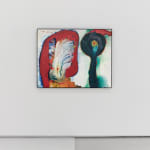Motonaga Sadamasa (1922–2011)
Work
Oil-based resin on canvas, framed
Signed by the artist on the reverse
1964
91 x 116 cm
92 x 118 cm (overall)
Further images
The present Work was made by Motonaga Sadamasa in 1964. In 1953, around the time when Motonaga started his career, he would paint figures in a representational style. But from 1954 onwards, his paintings were abstract. Such was his background when he submitted Work: Nail (Red White) to the First Outdoor Art Exhibition (billed as “The Experimental Outdoor Modern Art Exhibition to Challenge the Midsummer Sun”) of 1955, held in Ashiyagawa (near Kobe). Thereafter, Motonaga created Water and Smoke, both three-dimensional works, while at the same time producing abstract oil paintings. In 1957, he began to use oil-based resin colors, which featured the characteristic running-colors effect of his “Running Abstract” works. The first example of this series, done in 1957, was called From this Shape, but all subsequents efforts were simply titled Work. The artist would inscribe the signature “Motonaga” in kanji for the first time on Mr. Tapié (1958) and continued using it up to 1964. He used the oil-based resin medium until 1967 when he switched to acrylic colors with a new series also titled Work.
The present painting is structured by multi-layered areas of color that seem to be running towards the bottom, an approach prominently used by Motonaga since around 1959. One year later in 1960 he focused on primary colors, especially various reds, yellows and blacks. In many works done in 1962 and 63, Motonaga inserted small stones in the upper part, and in addition would use intensely colored layers, manipulating a sort of relief on the surface of the painting. For the present Work, done in 1964, it is peculiar that some colors are running from top to bottom, and others from side to side. When these streams of paint interact and float into each other, the resin colors mix provokes an intense sense of visual dynamism. The agglomeration of colors soaking into each other, the running and dripping pigment, and the way these movements unfold freely, yet are stopped again—it all contributes to a stimulating viewing experience defined by its competing vivid colors. In this painting, the pictorial space of intense, coexisting colors is thus compartmentalized by its “streams of pigment.”
In October 1966, Motonaga traveled to New York, where he stayed until October the following year. Upon his return to Japan, he converted from the oil-based resin medium to acrylic colors, opening up a new chapter in his art.
Motonaga Sadamasa (painter; 1922–2011)
Abstract painter from Mie Prefecture. Since 1955, Motonaga was a member of the Gutai Art Association, studying with Yoshihara Jiro. Motonaga received numerous national and international awards including the Contemporary Japanese Art Exhibition Award in 1964, and the Ordre des Arts et des Lettres (ranked as a chevalier) in 1988. His work encompasses mainly oil painting and print, and he is also known for his picture books. He received the Medal of Honor with Purple Ribbon in 1991.
The present painting is structured by multi-layered areas of color that seem to be running towards the bottom, an approach prominently used by Motonaga since around 1959. One year later in 1960 he focused on primary colors, especially various reds, yellows and blacks. In many works done in 1962 and 63, Motonaga inserted small stones in the upper part, and in addition would use intensely colored layers, manipulating a sort of relief on the surface of the painting. For the present Work, done in 1964, it is peculiar that some colors are running from top to bottom, and others from side to side. When these streams of paint interact and float into each other, the resin colors mix provokes an intense sense of visual dynamism. The agglomeration of colors soaking into each other, the running and dripping pigment, and the way these movements unfold freely, yet are stopped again—it all contributes to a stimulating viewing experience defined by its competing vivid colors. In this painting, the pictorial space of intense, coexisting colors is thus compartmentalized by its “streams of pigment.”
In October 1966, Motonaga traveled to New York, where he stayed until October the following year. Upon his return to Japan, he converted from the oil-based resin medium to acrylic colors, opening up a new chapter in his art.
Motonaga Sadamasa (painter; 1922–2011)
Abstract painter from Mie Prefecture. Since 1955, Motonaga was a member of the Gutai Art Association, studying with Yoshihara Jiro. Motonaga received numerous national and international awards including the Contemporary Japanese Art Exhibition Award in 1964, and the Ordre des Arts et des Lettres (ranked as a chevalier) in 1988. His work encompasses mainly oil painting and print, and he is also known for his picture books. He received the Medal of Honor with Purple Ribbon in 1991.







